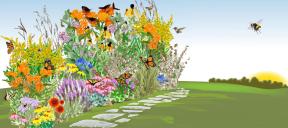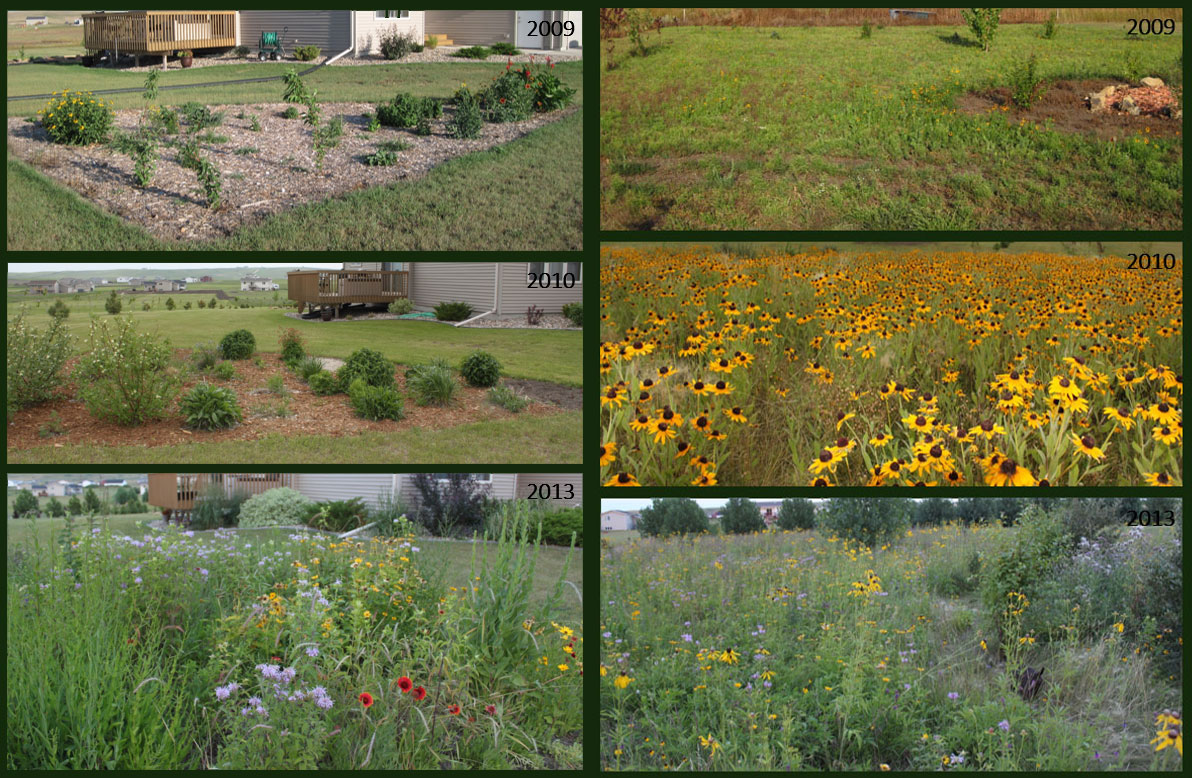
Gardening for Pollinators

Prairie plants develop slowly and some species may take 3-5 years or more before they will flower. Patience is the key to a successful and enjoyable prairie planting.
You can grow a pollinator garden of any size, from a few square feet to an acre or more. These gardens benefit monarchs and other pollinators while beautifying your yard or landscape.
There are a multitude of online resources to help you plan your garden or planting.
- Prairie Wildflowers and Grasses of North Dakota (pdf)
- Xerces Society - Many resources including books, fact sheets, identification guides, reducing harm to pollinators from pesticides
- Million Pollinator Garden Challenge - A collaboration of national, regional, and local gardening clubs to create pollinator habitat
- National Wildlife Federation Native Plant Habitats - Community, schoolyard landscapers and gardening tips
- North Dakota State University Extension Service - Resources include demonstration gardens and publications on designing gardens for butterflies and pollinators
- Pollinator Partnership - Gardening and planting guides, pollinator learning center
- U.S. Fish and Wildlife Service Pollinators - Podcasts and videos, pollinator gardens and trails, and more
- Additional Resources
Recommended Blooming Plants
Below is a listing of some of the grasses and flowering plants that are native to or grow well in North Dakota.
When possible, we recommend choosing an assortment of plants from each bloom period so that pollinators have resources across the entire growing season.
Common Name | Apr | May | Jun | Jul | Aug | Sep | Oct | Host To | Associated Wildlife |
|---|---|---|---|---|---|---|---|---|---|
x | x | Black Swallowtail | Small bees, flies, and other insects frequent the flowers for nectar. | ||||||
x | x | ||||||||
x | x | ||||||||
x | x | x | Duskywing | Moths, saw flies, and miner flies feed on foliage. Bees and hummingbirds visit frequently. | |||||
Golden Alexander | x | x | x | Black Swallowtail | |||||
x | x | ||||||||
x | x | ||||||||
x | x | ||||||||
Downy Paintbrush | x | x | x | ||||||
x | x | Key nectar source for skipper butterflies | |||||||
Wild licorice | x | x | |||||||
x | x | ||||||||
x | x | x | Monarch Butterfly | ||||||
x | x | x | Monarch Butterfly | ||||||
x | x | x | Monarch Butterfly | ||||||
x | x | x | |||||||
x | x | x | |||||||
x | x | x | Highly beneficial to native bees. | ||||||
x | x | x | Monarch Butterfly | Highly attractive to native bees and honey bees. | |||||
x | x | x | |||||||
x | x | x | |||||||
x | x | x | x | Frequently visited by bees and butterflies. | |||||
x | x | x | x | Painted Lady | |||||
x | x | x | x | ||||||
x | x | x | x | Frequently visited by butterflies. | |||||
x | x | x | x | Attracts long-tongued bees: miner, leaf cutting, and cuckoo bees. Attracts butterflies & hummingbird moths. | |||||
Plains Coreopsis | x | x | x | x | |||||
x | x | x | x | ||||||
x | x | x | Silvery Checkerspot | Attractive to many bees and flies, as well as some butterflies and beetles. | |||||
x | x | x | |||||||
Cup Plant | x | x | x | Attracts a number of birds | |||||
x | x | x | |||||||
Grayheaded Coneflower | x | x | x | ||||||
Ironweed | x | x | x | ||||||
x | x | x | |||||||
x | x | x | |||||||
Prairie Blazing Star | x | x | x | ||||||
x | x | x | |||||||
x | x | x | |||||||
x | x | x | |||||||
x | x | x | |||||||
x | x | x | |||||||
x | x | x | x | Attracts bees and butterflies. | |||||
Meadow Blazing Star | x | x | Attracts bees and butterflies. | ||||||
New England Aster | x | x | x | ||||||
x | x | x | |||||||
x | x | x | Pearl Crescent | Nectar and pollen attract many bees, flies, and butterflies. | |||||
x | x | x | The stems are perches for songbirds and the seeds are a late season bird food. Monarchs and other pollinators frequent the flowers. | ||||||
White Heath Aster | x | x | x |
Recommended Grasses
- Indian grass: Nesting site for many birds and insects. Many grasshoppers eat the foliage. Birds eat the seeds.
- Little bluestem: Host to Skippers (Dakota). Nesting site for songbirds and insects. Mining beetles, thrips, and leafhoppers eat the foliage. Birds eat the seeds.
- Side oats grama: Leafhoppers, grasshoppers, and stinkbugs eat the foliage. Birds eat the seeds.
- Big bluestem: Host to Ottoe Skipper. The caterpillars of several skippers (Dusted, Leonard's, Ottoe, etc.) feed on the foliage, as well as many beetles. Birds eat the seeds.
- Prairie dropseed: Grasshoppers and leafhoppers eat the foliage. Birds eat the seeds.
- Switchgrass
- Prairie junegrass
- Canada wild rye
- Indian grass: Nesting site for many birds and insects. Many grasshoppers eat the foliage. Birds eat the seeds.
- Junegrass
